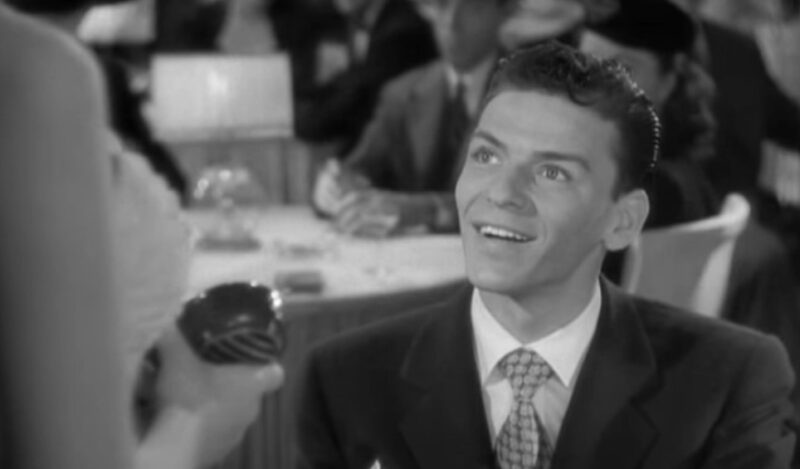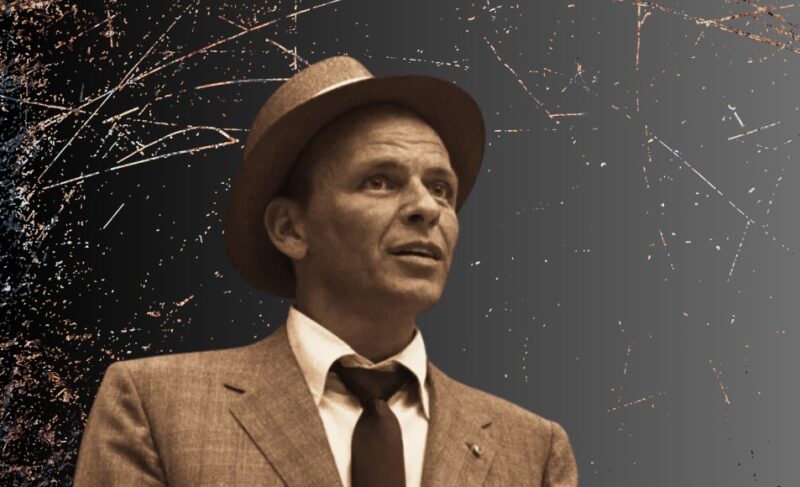Frank Sinatra, often lovingly referred to as ‘Ol’ Blue Eyes‘, stands as a legendary figure in American music. With a career spanning several decades and hits that continue to touch hearts worldwide, Sinatra has indelibly imprinted his style onto the music industry. From swing to jazz, pop to classic crooning, his body of work covers a wide spectrum of genres.
But can we neatly categorize his music into a single genre? That’s a question as melodious and intriguing as Sinatra’s discography itself.
Legacy and Genre Classification
Classifying Sinatra’s music into a single genre is a challenging task, but we must say that some kind of jazz/pop mashup would be the best way to name it.
His music is a melting pot of styles, drawn from a multitude of influences, and it is this diversity that makes Frank’s music so unique. Despite his association with specific genres, Sinatra’s music transcends them.
Whether it’s the emotional depth of his ballads, the infectious rhythms of his swing tunes, or the catchy melodies of his pop hits, Frank’s music continues to resonate with listeners across generations.
Since this is such a hard task, we must go through his career and see how his style formed over the years. It is impossible to understand the context without it.
Early Years

Sinatra began his musical career amid the rhythms of the Swing Era in the late 1930s.
As a young crooner, he started by performing with big band orchestras, including Harry James and Tommy Dorsey bands.
This period was characterized by his swinging rhythms and lush orchestral arrangements. Hits like “I’ve Got You Under My Skin” and “Fly Me to the Moon” were products of Frank’s big band association.
The orchestration provided a dynamic background to his vocals, which soared above with a youthful exuberance.
The harmonies were tight, the rhythm infectious, and Sinatra’s voice effortlessly weaved through them, displaying his innate talent and understanding of the genre.
The Great American Songbook
Sinatra’s role in popularizing the Great American Songbook can’t be understated.
The genre focuses on timeless classics, mostly composed for Broadway and Hollywood between the 1920s and 1950s.
Frank masterfully interpreted these songs, adding a touch to his unique style.
Renowned composers and lyricists like Cole Porter and Irving Berlin were among his frequent collaborators.
Sinatra’s renditions of their work helped these songs transcend their original context and enter the popular consciousness.
His powerful interpretations turned songs like Porter’s “I’ve Got You Under My Skin” and Berlin’s “Cheek to Cheek” into timeless classics.
Jazz
Jazz forms an integral part of Sinatra’s musical palette. With its roots in improvisation and individual expression, jazz allowed him to showcase his mastery of phrasing and dynamics.
Frank didn’t merely sing; he infused the melodies with his personal style, giving it an emotional depth that touched listeners.
Sinatra worked closely with jazz musicians such as Count Basie and Duke Ellington, blending his voice with their swinging rhythms and improvisational flair.
Albums like “Sinatra at the Sands” with the Count Basie Orchestra demonstrate Sinatra’s affinity for jazz and his talent for reinterpreting songs within this genre.
Pop Music
In the 1950s and 1960s, the singer successfully transitioned to a pop style, showcasing his versatility.
His chart-topping hits like “Strangers in the Night” and “My Way” continue to be stalwarts of the pop genre.
The melodies were catchy, and the lyrics, often about love and longing, resonated with a broad audience.
Sinatra’s smooth delivery and charismatic stage presence only added to his appeal.
Moreover, his influence extended to subsequent pop artists, making him a defining figure in the pop music landscape.
The Crooner Style
The term ‘crooner’ often evokes images of Sinatra with his fedora and microphone, delivering smooth and sophisticated vocals.
The crooner style is characterized by intimate, emotional performances and a vocal technique that makes full use of the microphone’s amplification capabilities.
Sinatra was among the genre’s most prominent figures. His renditions of songs were warm and emotive, often tinged with a sense of melancholy that connected with listeners on a personal level.
Other notable crooners, like Bing Crosby and Dean Martin, also left their mark on popular music, but it was Frank who truly epitomized the crooner style.
Sinatra’s forays into other genres

Throughout his illustrious career, Frank Sinatra was known for his versatility and willingness to explore different creative styles.
While he is primarily associated with genres such as swing, jazz, and the Great American Songbook, Frank also ventured into other genres, showcasing his adaptability and expanding his artistic horizons.
One notable genre that Sinatra explored was rhythm and blues (R&B). In the 1950s, as R&B gained popularity, Sinatra incorporated elements of this genre into his music.
His renditions of songs like “I’ve Got a Crush on You” and “The Tender Trap” showcased his ability to infuse R&B influences into his signature crooning style, adding a touch of soulful flair to his performances.
As an artist, he made forays into the emerging genre of rock ‘n’ roll. In the late 1950s and early 1960s, he recorded several songs that showcased his willingness to embrace the energetic and rebellious spirit of the genre.
Tracks like “Witchcraft” and “High Hopes” demonstrated Sinatra’s ability to incorporate rock ‘n’ roll elements into his songs, creating a fusion that appealed to both his loyal fan base and younger audiences.
Furthermore, Frank delved into the world of bossa nova, a Brazilian music genre that gained popularity in the 1960s.
Inspired by the success of Stan Getz and João Gilberto’s hit single “The Girl from Ipanema,” Sinatra recorded an entire album, “Francis Albert Sinatra & Antonio Carlos Jobim,” featuring bossa nova arrangements.

This collaboration introduced Sinatra to a new audience and showcased his willingness to embrace international influences. Sinatra’s exploration of these diverse genres demonstrated his musical curiosity and his ability to adapt his style to fit different musical landscapes.
He effortlessly incorporated elements from R&B, rock ‘n’ roll, and bossa nova into his creations, maintaining his distinct vocal style while adding new dimensions to his performances. If you’re a fan of Sinatra’s rich and deep tone, check out our list of country singers with deep voices.
By venturing into these genres, Frank not only expanded his artistic range but also appealed to a broader audience. His willingness to embrace different musical styles showcased his adaptability and helped solidify his status as one of the most influential and enduring figures in popular music.
In conclusion, the singer forays into other genres demonstrated his artistic versatility and willingness to explore new musical territories.
Whether infusing R&B influences into his crooning style, embracing the energetic spirit of rock ‘n’ roll, or delving into the enchanting world of bossa nova, the man left an indelible mark in each genre he explored.
These adventures further solidified his status as an iconic and innovative artist, continually pushing the boundaries of his craft and captivating audiences with his unique blend of talent and versatility.
Summary
The genre of Frank Sinatra’s music is a tapestry woven with threads from swing, the Great American Songbook, jazz, pop, and crooning.
It’s a foundation of his talent and versatility that his music cannot be confined to a single genre.
His music’s defining quality lies in its ability to evoke emotions and tell stories, rather than adhere to a specific musical style.
Through this, he has left a lasting legacy, continuing to influence artists and charm audiences, proving that his music is as timeless as the man himself.







